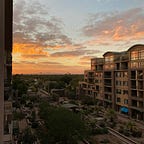Growing Power: Solar energy and soil conservation for rural communities
It’s already common in many rural areas worldwide to see wind turbines towering above farms and ranches. These turbines contribute to a cleaner energy grid and generate steady income—lease terms vary and depend on the size of the installation, but farmers receive $4,000-$8,000 on average for each turbine each year. The revenue from wind contracts can be far more reliable and less subject to price fluctuations and variable climate than the standard yearly risks of raising crops.
A less-visible, but growing segment of the energy market—solar—has the same potential to stabilize farm communities and produce renewable energy. As climate change and overuse strain water resources and raise irrigation costs, especially in desert regions like the Southwest US, rural areas lose jobs and tax revenue when agricultural production slows. Solar energy development allows marginal cropland to continue generating income with little to no water use.
Installing solar on previously agricultural land reduces the need to disturb more valuable forests, grasslands, and recreational spaces to meet clean energy goals. Some trials have even found potential for growing shade-tolerant crops like lettuce directly below solar panels with no decrease in output, further reducing the land conflict between energy and food production.
Solar installations tend to make the most economic sense on cheap rural or desert land, far from the urban centers that ultimately use most of our electricity. The added cost of transmission raises the price of this energy, making it less competitive with dirtier traditional sources. One way to mitigate this infrastructure issue is to site renewables near existing wires with the capacity to carry new generation. The long-distance transmission network crisscrossing rural areas is the natural place to explore future energy development, right down to the low-volume connections that run to small towns and individual farms.
With investment, it is possible to upgrade the connections to the electric grid that farms and rural businesses already need to receive power into two-way routes capable of selling back to the grid. This allows the roof or land of a property to start generating clean energy and income for the owner, directly in the community making the investment.
Pairing solar + soil restoration compounds environmental benefits
Careful management of rural land is a key strategy for sequestering carbon to combat climate change and meet international emissions reduction targets. Plants pull carbon from the atmosphere and store it as they undergo photosynthesis, pumping carbohydrates underground to store in roots and trade with the complex microbiomes that recycle nutrients throughout the soil system. This natural process is a cheap, effective, scaleable way to remove carbon dioxide from the atmosphere that requires few human inputs and no technological breakthroughs.
In response to soil loss and degradation, especially the dramatic Dust Bowl conditions of the southern Great Plains, the original New Deal mobilized nationwide to improve agricultural land use through agencies like the Soil Conservation Service. A modern Green New Deal must include regenerative agriculture practices that build up soil and ecosystems. Existing programs for the US Departments of Agriculture and Energy already give technical and financial support to farmers interested in deploying solar and should ramp up to meet our climate and energy needs.
Some rural landowners have struck deals to develop parts of their properties with solar while leaving large sections undisturbed to regenerate habitat. The stable added revenue from long-term solar contracts could reduce financial pressures on land managers interested in more sustainable practices but unable to justify the costs of investment and transition.
Solar and restoration projects can integrate even more finely by installing panels on degraded fields with soil too poor to cultivate, or in the otherwise-barren edges of center-pivot irrigated fields. Just as cattle worldwide already graze beneath wind turbines, sheep can help manage overgrown vegetation on solar farms, reducing maintenance cost, generating extra income, and sequestering more carbon.
On a smaller scale, rural co-ops and small utility providers can evaluate siting solar close to the customer base by identifying owners of degraded farmland that could benefit from a solar project lease. Especially as policies like carbon credits designed to reward projects that cut greenhouse gases become more widespread, the combined climate benefits of clean energy and soil sequestration should motivate more deployment of solar in agricultural areas.
Policy can encourage solar firms to consider the ecosystem and biodiversity effects of their choice of what to plant alongside their panels; for example, Michigan rates solar installation sites on how well they provide habitat and a diversity of flowering native plants for pollinators. Proper ground cover planting also calms stormwater runoff, reducing erosion and aiding groundwater recharge. The intersecting environmental benefits of proper soil management warrant close attention to how rural land is treated during the necessary wide-scale deployment of clean energy generation.
